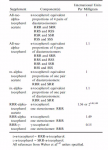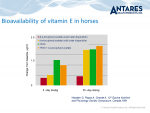criso
Coming over here & taking your jobs since 1900
It was never 1/10 of the strength though.
Gravenhorse listed an E500 product that supplied 5000iu in 10g. We still have screenshots.
Nutjob highlighted that FP said their 25% 250mg/ kg product supplies 500iu and they claim 2000iu in 4g.
So initially both agreed on the amount supplied per gram.
After challenging Gravenhorse revised this to a 250mg/kg product that supplies E350iu
I'm going to quote Gravenhorse from earlier where there is some detail on the conversion from mg to iu
PE may have confused the 2 and equated mg with iu.and may be underestimating as they seem to be suggesting 250mg/g = 250iu
FWIW I suspect they're all the same product, the difference is not what is being sold but how the availability is being interpreted.
Gravenhorse listed an E500 product that supplied 5000iu in 10g. We still have screenshots.
Nutjob highlighted that FP said their 25% 250mg/ kg product supplies 500iu and they claim 2000iu in 4g.
So initially both agreed on the amount supplied per gram.
After challenging Gravenhorse revised this to a 250mg/kg product that supplies E350iu
I'm going to quote Gravenhorse from earlier where there is some detail on the conversion from mg to iu
With regard to product strength, the feed industry has traditionally used the International Units system for vitamin concentrations. However it is now moving to use mg/kg or grams/tonne (means the same). In the course of e-mail & phone conversations earlier today with fellow nutrionists at both my suppliers, confusion arose between the 2 systems. 1 mg of natural rrr alpha tocopherol acetate is the same as 1.49 i.u of vitamin E . As the supplied product contains 25% pure Vit E oil, this equates to 375,000 i.u./kg. I have rounded it down to 350,000.
PE may have confused the 2 and equated mg with iu.and may be underestimating as they seem to be suggesting 250mg/g = 250iu
FWIW I suspect they're all the same product, the difference is not what is being sold but how the availability is being interpreted.



